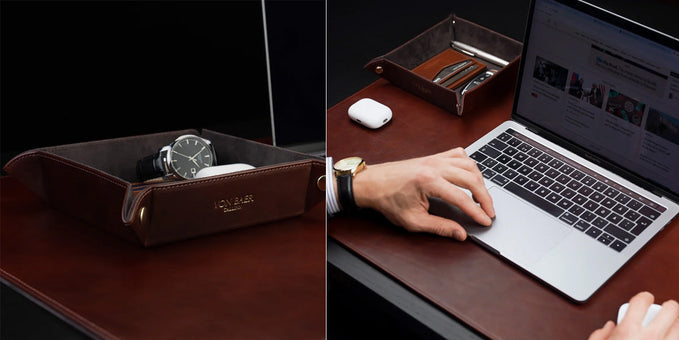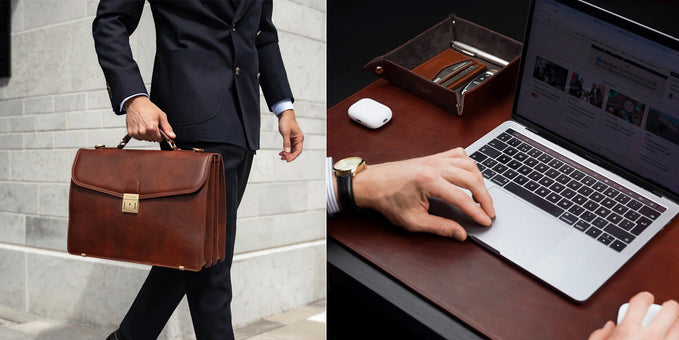Faux Leather

Faux leather, also known as imitation leather, leatherette, and vegan leather, is one of the most popular materials used to make high-fashion clothing, shoes, handbags, and home furnishings today.
In this guide to faux leather, we’ll explain everything you need to know about this versatile fabric to help you decide if it is the right choice for your next purchase.
What is faux leather?
Faux leather is a synthetic material designed to look and feel like genuine leather. Typically, it has a polyester or cotton base layer coated with polyurethane or polyvinyl chloride (PVC) topcoat to give it the same texture and finish as animal hide. Imitation leather manufacturers then use dyes, waxes, and various finishing techniques to create an artificial grain or patent finish.
While considerably cheaper than genuine leather, high-quality faux leather offers the same qualities. It is durable, aesthetically pleasing, and eco-friendly, especially when made from plant-waste or recycled materials, making it the ideal choice for furniture upholstery, footwear, and designer goods.
Types
Just like genuine leather, there are many distinct types of faux leather, with PU Leather and PVC Leather being the most popular options. Here we compare the two:
PVC Leather
PVC leather, manufactured with polyvinyl chloride and various chemicals, became popular in the 1960s and 1970s when fashion designers and furniture manufacturers sought a cheaper alternative to genuine leather. However, it is not quite as popular today.
Due to its PVC plastic content, this type of vegan leather is not considered environmentally friendly. As such, most designers and manufacturers choose not to use it in their collections.
PU Leather
PU leather (polyurethane leather) is considered more eco-friendly than PVC leather but still includes plastics. Typically, full-synthetic PU leather features a polyester base with a plastic coating. However, you can also purchase semi-synthetic PU leather with a natural leather base and a plastic topcoat.
While both options of PU leather are suitable for furniture upholstery and manufacturing clothes and shoes, semi-synthetic PU leather is not 100% vegan and must not be marketed as such.
Related:
- Leather
- Vegan leather
- Faux leather vs real leather
- Bonded leather
- Genuine leather
- Pleather
- Top grain leather
- Leather types
- Leather guide for beginners
- What is leather patina
- Vegetable tanned leather
- Leather tanning
- What is artificial leather?
- What is full grain leather
How Much Does Faux Leather Cost?
One of the reasons faux leather is so popular is that it costs considerably less than genuine leather. You’ll pay as little as $20 to $30 for a small vegan leather handbag, but a real leather bag of the same size will cost you $100 or more.
Furniture and clothing manufacturers can purchase large sheets of faux leather at competitively low prices and pass on considerable savings to the consumer. It’s a win-win for everyone.

Pros and Cons of Faux Leather
Pros
- Hardwearing
- Durable
- Versatile
- Affordable
- Stylish
- Easy to manufacture
- Cruelty-free
It’s A Non-Animal Byproduct
Another reason faux leather is popular is that it is a non-animal byproduct. No animals are harmed in the making of this type of material, so it is the perfect choice for anyone following a vegan diet.
Faux Leather Versatility
The beauty of faux leather is that it comes in a veritable rainbow of colors, styles, textures, and finishes, just like genuine leather. You can dye it to complement any interior design project, add unique patterns to create a one-of-a-kind upholstery fabric, and maintain it with ease. It is one of the most versatile materials available today that allows infinite styling options.
New Technology Is Making Faux Leather More Eco-Friendly Than Ever Before
Thanks to advances in technology and manufacturing, faux leather is more eco-friendly than ever before. While PU leather and PVC leather are still widely available on the marketplace, new fabrics made from plant, organic, and recycled materials are fast replacing plastic and fossil-fuel-based alternatives.
Today, manufacturers can make imitation leather from pineapple fibers, mushroom fibers, fruit waste and cereal crops, and faux leather is fast becoming a 100% vegan, environmentally friendly material.
Faux Leather is Low Maintenance
Unlike genuine leather, faux leather is easy to clean and maintain. It doesn’t crack or soak up stains, and you can wipe it down with a damp cloth to remove any dust, dirt, or air pollutants. It is one of the most low-maintenance materials available, and while it will eventually fade if left in direct sunlight all day, it will keep its color much longer than real leather.
Cons
While faux leather comes with a long list of benefits, like any material, it also has a list of cons:
- It doesn’t age like genuine leather, so if you adore the lustrous patina and the timeless imperfections of aged-leather sofas, this is not the material for you.
- It will never look better than it does the day you buy it. While durable, bonded faux leather will eventually peel or split, particularly in furniture upholstery.
- It is not breathable. Imitation leather typically has a plastic coating, so it doesn’t ‘breathe’ like genuine leather or natural materials such as cotton.
- Most faux leather fabrics are not environmentally friendly; however, manufacturers are working on this by replacing plastics and chemicals with plant-based materials.
- It is more likely to tear than genuine leather due to its lack of natural elasticity. Real leather sofas are almost impossible to rip, but faux leather sofas can puncture or tear apart at the seams, especially if they are not well-bonded.
- It’s non-hypoallergenic and not ideal for those with allergies or sensitivities to petroleum. However, top-quality faux leather furniture will unlikely give off allergy-inducing compounds.
Related articles:
- Where does leather come from
- Mushroom leather
- Napa leather
- Pebbled leather
- Leather grades
- How is leather made
- Suede
- PU leather
- Bonded leather vs Faux leather
FAQs
Here is a list of our most frequently asked questions regarding faux leather:
Is It A Good Choice for Upholstery?
Yes, but not for all types of furniture. While you can use it for sofas, chairs, and sectionals, it cannot withstand heavy-duty use like genuine leather and may soon show signs of wear and tear if used in a busy family room, bar, or restaurant. It is, however, perfect for decorative items such as headboards, scatter cushions and backrests.
How Does It Compare to Genuine Leather?
In terms of aesthetics, faux leather and genuine leather are remarkably similar, but that is where the similarities end. Full-grain leather furniture and shoes last considerably longer than the imitation alternatives, but they are much more expensive, so it is all about weighing up the pros and cons.
Are Faux Leather Sofas A Wise Investment?
One of the many benefits of buying a faux leather sofa is that it will not cost you the earth, and it will not fade or stain like a genuine leather couch, but in terms of longevity, it might not last. Imitation leather sofas can have a ‘plastic’ feel, and if subjected to daily use, they can soon begin to show signs of damage around the seams. If you want to buy a leather couch that lasts, genuine leather is a wiser investment, but it will cost 3 to 4 times more than a synthetic alternative.
Which is the Best Faux Leather?
While all faux leather fabrics have their pros and cons, PU leather is the most commonly used to make furniture and bags. It looks and feels almost as good as the real thing, and you can use it to create any leather imitation product. Modern plant-based faux leathers are still a work in progress; only time will tell if they meet expectations.
Does Faux Leather Furniture Last?
Buy a faux leather couch, recliner, or sectional, and you can expect it to last up to five years, depending on how much you use it. Buy a genuine leather sofa, and it could last 25 years or more with regular maintenance, so it’s all about weighing up the pros and cons.
Related:
- Repair cat scratches on leather
- Remove water stains from leather
- Clean leather wallet & remove stains/smells
- Remove ink from leather
- Get smell out of leather
- Remove stains from leather shoes
- Clean suede leather bag
- How to reform a leather bag
- How to maintain leather bags
- Repair cracked leather
- Wet leather
- How to clean leather bag
- How to restore faded leather bag
- Italian leather
- How to tell if leather is real
- Buffalo leather
- Suede vs Leather
- What is Real Leather
- Pu Leather vs Faux Leather
- Alternative Leather
- Chrome Tan Leather
Why Does Faux Leather Peel?
Unlike genuine leather, faux leather has two layers, typically a polyester backing covered with a plastic topcoat. Over time, these two layers can begin to separate and cause peeling. Once this happens, repairing is difficult, although you can re-upholster certain parts of your couch, such as the armrests, to give your sofa a new lease of life.
Is It Toxic?
During the manufacturing of faux leather, toxic chemicals are used to give the fabric a leather effect. Why most imitation leather products are deemed suitable for human use, PVC leather contains dioxins and phthalates, thought to be detrimental to health, and PU leather may contain dimethylformamide or DMF, a potent toxin to humans.
Conclusion
We hope you enjoyed our article on "leather".
If you have any questions, leave them in the comments, or email Von Baer at info@vonbaer.com.
Browse related leather pages here.

Author: Albert Varkki
Albert Varkki is the co-founder of Von Baer. He understands leather products as a consumer, supplier, and a manufacturer, helping you with the inside knowledge you need, to choose the perfect leather product for you.
We strive for the highest editorial standards, and to only publish accurate information on our website.
Leave a Comment
Your email address will not be published.






